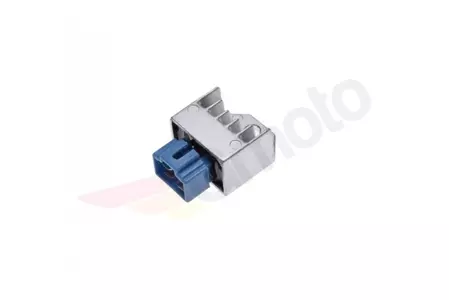Voltage regulator
€120.18 including VAT
Product available on special order. Delivery time may be delayed by 7 days. No returns.
We keep up with your passion!
Delivery tailored to your needs
You have 15 days to make a decision
Voltage regulator
- Regulator/rectifier with MOSFET technology
- Replacement part in original quality
- This new technology has innovated the concept of three-phase ladder regulators. For many years, these devices used silicon-controlled rectifiers (SCRs) to direct excess energy from the alternator to ground to maintain a constant battery voltage.
- This was generally accepted and proved suitable for small and medium-sized generators in internal combustion engines. However, new regulator technology based on MOSFET transistors is becoming increasingly popular due to its better performance and many other interesting advantages over SCR.
- The energy requirements of modern motorcycles and ATVs are now increasing due to the use of additional electronic modules, such as fuel injection systems, high-performance lighting, numerous accessories, etc. This means a large amount of energy coming out of the generator, and the SCR bypass regulator is no longer able to regulate this.
- The main reason is low energy efficiency, the internal losses of the regulator lead to overheating and premature failure when more than 35A current flows through the regulator. As a result, SCR technology has reached its limit and is therefore not recommended for large vehicles with high energy consumption.
- To solve this previously mentioned problem, it was necessary to reduce circuit losses. When the SCR is active (generator current to ground), there is a high voltage drop in the forward direction (about 1.5V @ 35A) because it acts as a power diode. If the current now increases, the power loss (e.g., heat) will increase in parallel.
- DEVICE POWER LOSS (W) = CONDUCTION CURRENT (A) X VOLTAGE DROP (V)
- Advantages:
- 3-PHASE SHUNT REGULATOR WITH HIGH ENERGY EFFICIENCY
- OUTPUT POWER OF UP TO 50A
- PRECISE ELECTRONIC CONTROL OF BATTERY VOLTAGE PREVENTS INTERRUPTIONS IN IGNITION
- REDUCED HEAT GENERATION LEADS TO LONGER SERVICE LIFE
- LOW-POWER STANDBY MODE WHEN THE VEHICLE IS NOT IN USE
- Unlike other transistors, MOSFETs can be characterized as voltage-controlled switches because their completely different semiconductor architecture makes them more efficient in power consumption.
- When used, they behave like a low-rated resistor for high currents, conducting all excess current from the generator to ground. As a result, the voltage drop is very low (less than +/-0.2 V at 35 A), and power dissipation is drastically reduced. This has a direct impact on reduced heating and long regulator life.
- MOSFET technology has been continuously improved in recent years due to its wide application in consumer and industrial electronics. Semiconductor integration technology offers higher power with reduced space and excellent performance. They also allow faster switching, higher reliability and better control in heavy applications.
- Rectifier diode power is another important factor when it comes to power dissipation. Since all the output current flows through them, they must offer both high robustness and stability, as well as efficient current control. Our MOSFET controllers use high-current rectifier diodes with extremely low voltage drop to prevent overheating and meet the previously mentioned requirements.
- The internal CONTROLLER has been completely redesigned to meet the requirements of the MOSFET transistor. The battery voltage is continuously monitored to adjust the output current for different consumption situations. The new electronic control avoids the use of an ignition wire, reduces the number of connections and simplifies the wiring topology. It also features low standby power consumption, resulting in very little battery discharge when the vehicle is not in use.
- This new technology therefore allows the regulator's output to be increased to 50A while maintaining excellent voltage regulation. Additional benefits such as reduced heating, high efficiency and advanced electronic control make this new regulator the first choice for controlling a vehicle's battery circuit.
Fits to
- Kymco AK 550 i. ABS 2017
- Kymco AK 550 i. ABS 2018
- Kymco AK 550 i. ABS 2019
- Kymco AK 550 i. ABS 2020
- Kymco AK 550 i. ABS 2023
- Kymco K-XCT 125 i. 2013
- Kymco K-XCT 125 i. 2014
- Kymco K-XCT 125 i. 2015
- Kymco K-XCT 125 i. 2016
- Kymco K-XCT 125 i. 2017
- Kymco K-XCT 300 2013
- Kymco K-XCT 300 ABS 2015
- Kymco K-XCT 300 i. 2014
- Kymco K-XCT 300 i. 2015
- Kymco K-XCT 300 i. 2016
- Kymco K-XCT 300 i. 2017
- Kymco K-XCT 300 i. ABS 2016
- Kymco K-XCT 300 i. ABS 2017
- Kymco Xciting 400 euro4 i. ABS 2017
- Kymco Xciting 400 euro4 i. ABS 2018
- Kymco Xciting 400 euro4 i. ABS 2019
- Kymco Xciting 400 euro4 i. ABS 2020
- Kymco Xciting 400 i. 2016
- Kymco Xciting 400 i. 2017
- Kymco Xciting 400 i. ABS 2014
- Kymco Xciting 400 i. ABS 2015
- Kymco Xciting 400 i. ABS 2016
- Kymco Xciting 400 i. ABS 2017
- Kymco Xciting 400 S euro4 i. ABS 2019
- Kymco Xciting 400 S euro4 i. ABS 2020
Questions & Answers
Have a question about this product?
No one has asked a question about this product yet. Be the first and get an answer from our community or experts!




































